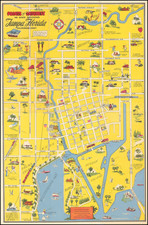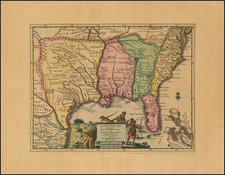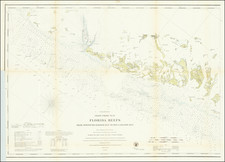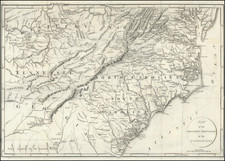The British Empire in North America
Rare George Willdey edition of Philip Lea's rare map of the British Colonies (Jamaica, Port Royal, Florida, Caribbean and The English Empire in America).
As noted by Burden, the map was first advertised in the Term Catalogues for Trinity Term 1685, published in June 1685. It is not referred to in Lea's 1685 catalogue, but appears in the catalogue of 1687.
The map is divided into three parts, the lower part being a detailed map of the island of Jamaica, naming all the plantation owners. It bears an inset lower left entitled A New Draught of Port Royal by Anthony Williams. The upper part of the map shows the Gulf of Mexico and the southeastern portion of North America. A large B. Sp of Santo represents the mouth of the Mississippi River, Florida includes a similarly named river on the west coast, and S Augustine on the eastern shore.
The final two maps extend to the Carolinas, with the ports of Charles Towne and Port Royall noted. A large inset map in the upper right is entitled The English Empire and extends the coverage of the map northwards through New England, centered on the Chesapeake. This map provides an accurate depiction of the British Colonies along the Eastern Coast of North America as it stood in the mid 1680s. The new colony of Pennsylvania is shown, as is the capital city, misspelled Philidolphia. The four vessels plying the waters offshore indicate the level of trading activity.
It should be noted that while Philip Burden lists the map as issued by Willdey circa 1715, Ashley Baynton-Williams has provided compelling evidence that this conclusion is not correct. Mr. Baynton-Williams notes that the sale of Anne Lea's stock (widow of Philip) was announced in 'Daily Journal' of August 5th 1730, as to be held on the 14th. Willdey first advertised his re-issuance of the Lea maps in an advertisement in the 'Daily Post' for February 3rd 1732.
Rarity
The Willdey edition of Lea's map was unrecorded until 1986, when an example was located in a copy of a Willdey Atlas was sold at Sothebys. Only a few examples have since been located. The Lea Map has appeared in dealer catalogues only 2 times in the past 23 years (Arkway Catalog 58 (2004) $6,500 and Shapero, Pilots of the Caribbean (2007) $9000) . Only 1 example of the Willdey edition has appeared in the past 35 years (1987--Arkway Catalog, $1900).
We offered the Duke of York's copy of the map for sale in 2009.
Philip Lea (fl. 1683-1700) was a central figure in the London map community at the end of the eighteenth century. He apprenticed under Robert Morden, with whom he later collaborated. Lea was made free of the Weavers Company in 1689. He was a publisher and a globe and instrument seller with ties to members of government. For example, Samuel Pepys lists him as his map advisor and colorist. He was not known primarily for his own original works, but for his reworking and reissuing of the work of others, particularly the county maps and world map of Christopher Saxton. He also acquired plates from John Seller, John Ogilby, and William Morgan, among others. Later in his career, he collaborated frequently with Herman Moll. After his death in 1700, Philip’s wife, Anne, carried on the business for several decades.
George Willdey was an optical instrument maker. He also sold globes, maps, and toys at his shop in Ludgate Street. Born in Staffordshire, Willdey moved to London after the death of his father, where he was bound as an apprentice to John Yarwell, an optician. He was made free of the Spectaclemakers’ Company in 1702, when he began work as a journeyman.
A few years later, Willdey started in business with Timothy Brandreth, working under the sign of the Archimedes and Globe. They competed for business with Yarwell and other opticians, advertising their wares in trade cards and periodical advertisements.
Willdey and his wife, Judith, had five children, three of which survived to adulthood. Judith was a Huguenot, which allowed Willdey to create a wider network of artisans and craftsman. He expanded his stock to toys and household decorations, in addition to instruments. From 1709 he also sold printed goods, including maps and globes, which he sold in partnership with John Senex. Willdey purchased the copper plates for many maps, such as Christopher Saxton’s atlas of England and Wales.
We note the following addresses:
- From 1707 to 1713 he operated "At the Archemedes & Globe, Ludgate Street." sometimes described as "Archimedes and Globe next the Dog Tavern nearer Ludgate."
- In 1712 in partnership with Timothy Brandreth also advertised at Archimedes and Globe over against the Royal Exchange in Cornhill.
- In 1715 his location was described as "At the Great Toy and Print Shop, the corner of Ludgate Street, next to St. Paul's"
- 1718 to 1737 as "At the Great Toy, Spectacle, China-Ware, and Print Shop, the Corner of Ludgate Street near St. Pauls London."
In 1717, Willdey split with Brandreth and expanded his stock further to include coffee and tea, snuff, medicine, china, and cutlery. He sold these wares from his shop at Ludgate and St. Paul’s Churchyard. He aggressively advertised his business in hundreds of newspaper advertisements; he also adopted many advertising gimmicks, such as erecting a giant burning glass on the roof of his store. Willdey was a leader in the Spectaclemakers’ Company. His wife frequently helped with the business and eight of his fifteen apprentices were women, which was very unusual for either the instrument and toy trades at the time.
Willdey died in 1737, although he had been in declining health for years and had tried to pass the business to his son, Thomas. He was remembered in The Old Whig, or, the Consistent Protestant as the “most noted Toyman in Europe.” After his death, the shop was run by Judith along with a former apprentice, Susanna Passavant. Thomas, it seems, was not suited to business.
Willdey’s daughter, Jane Frances, married a Peter Fenoulhet, clerk of the entries in the Excise Office. Fenoulhet sued on behalf of their son over the mismanagement of the family business by Thomas. These lawsuits produced eleven inventories of household and commercial stock between 1730 and 1737, the only extant shop accounts from the London instrument trade from this period.









![[ Pictish Man Holding Severed Head ] Picti icon](https://storage.googleapis.com/raremaps/img/small/99837.jpg)




